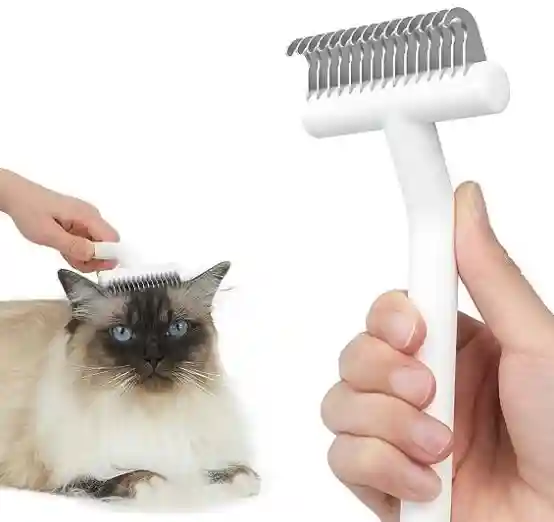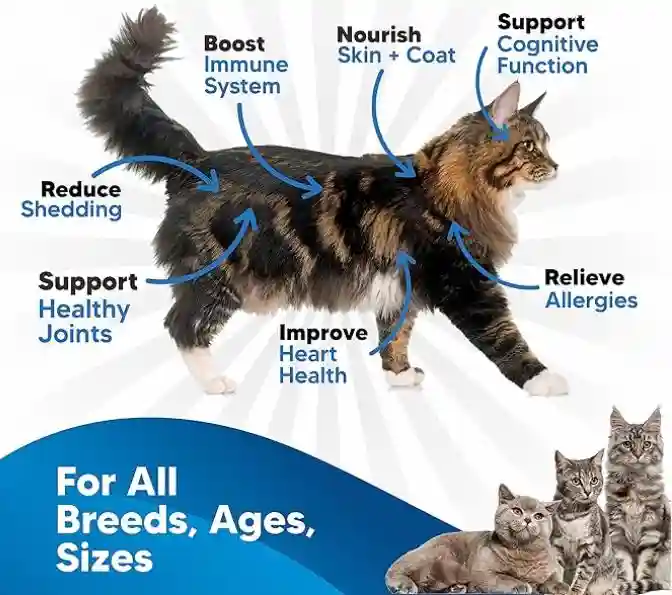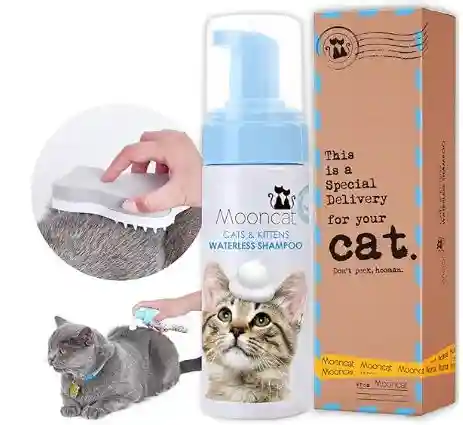Hello Everybody! Today, we discuss a common term we are all familiar with. Many cat owners often encounter the common issue of cat dandruff. It not only affects the appearance of your feline companion but can also be a sign of an underlying health problem. In this comprehensive guide, we will delve into the world of cat dandruff, exploring its causes, effective treatments, and prevention strategies to ensure your beloved pet has a healthy and lustrous coat.
Cat Dandruff: An Overview
What is Cat Dandruff?
Cat dandruff refers to the presence of dry, flaky skin on a cat’s fur, often accompanied by itching. These flakes can be white or yellowish and are more noticeable on dark-colored cats.
Understanding the Causes
Cat dandruff can be attributed to various factors, including:
- Dry Environment: A lack of humidity in the air can lead to dry skin in cats, resulting in dandruff. This means that when the air around your cat lacks moisture, their skin can become dry and flaky. Dry skin is more prone to shedding dead cells, which manifest as dandruff. To address this issue, consider using a humidifier in your home, especially in dry climates or during the winter months. Increasing the humidity levels can help keep your cat’s skin properly hydrated, reducing the likelihood of dandruff.
- Poor Nutrition: Inadequate intake of essential fatty acids can affect skin health. Cats, like humans, require certain nutrients for healthy skin. Essential fatty acids, such as Omega-3 and Omega-6, play a crucial role in maintaining skin moisture and preventing dryness. If your cat’s diet lacks these essential nutrients, their skin can become dry and prone to dandruff. To combat this, ensure your cat is fed a well-balanced, high-quality cat food that includes these essential fatty acids. Your veterinarian can provide recommendations for the right diet to promote healthy skin.
- Allergies: Cats can be allergic to certain foods, which may cause skin issues. Just like humans, cats can develop allergies to specific foods. When a cat consumes something they are allergic to, it can trigger various reactions, including skin problems. Allergic reactions can lead to skin inflammation, itching, and ultimately, dandruff. If you suspect your cat has food allergies, consult your veterinarian for guidance on identifying and eliminating allergens from their diet. This can help alleviate skin issues and reduce dandruff.
- Parasites: Fleas and mites can irritate a cat’s skin, leading to dandruff. External parasites, such as fleas and mites, can infest a cat’s fur and skin. These tiny pests can cause intense itching, skin irritation, and discomfort. In response to the irritation, cats may scratch or bite their skin, leading to the shedding of dead skin cells in the form of dandruff. To prevent this, implement a robust flea and parasite control program for your cat. Regular grooming and inspecting your cat’s fur can also help detect and address parasite infestations early.
- Underlying Medical Conditions: Conditions like dermatitis or fungal infections can contribute to dandruff. Sometimes, dandruff in cats is a symptom of an underlying medical condition. Dermatitis, which is inflammation of the skin, or fungal infections can disrupt the normal balance of the skin and lead to dandruff. If your cat’s dandruff persists despite addressing environmental factors and diet, it’s crucial to consult your veterinarian. They can perform diagnostic tests to identify any underlying medical issues and develop a treatment plan tailored to your cat’s specific needs.
Diagnosing Cat Dandruff

Recognizing the Symptoms
To identify cat dandruff, look out for the following signs:
- Flaky Skin: Noticeable flakes on your cat’s fur, especially along the back and tail.
- Excessive Scratching: Frequent scratching or biting at the skin.
- Hair Loss: Areas of thinning or baldness in the coat.
- Redness or Irritation: Inflamed or irritated skin.
Consultation with a Veterinarian
If you suspect your cat has dandruff, consult a veterinarian for a thorough examination. They can determine the underlying cause and recommend appropriate treatment.
Cat Dandruff Treatment Options

Proper Grooming
Proper grooming is a fundamental step in managing and preventing cat dandruff. This process involves regular care and maintenance of your cat’s coat, and it serves several important purposes in combating dandruff:
- Removal of Dead Skin Cells: Grooming helps in the gentle removal of dead skin cells from your cat’s coat. Dandruff is essentially an accumulation of these dead skin cells, which can make your cat’s fur appear flaky and dull. Regular brushing or combing helps loosen and eliminate these flakes, revealing healthier skin underneath.
- Distribution of Natural Oils: Cats have natural oils in their skin that play a vital role in maintaining skin health and preventing dryness. Grooming aids in distributing these oils evenly throughout the fur. This distribution not only moisturizes the skin but also imparts a glossy, lustrous appearance to the coat.
- Stimulation of Blood Flow: Grooming sessions also stimulate blood circulation to the skin. Improved blood flow can enhance the health of the skin by ensuring that it receives adequate oxygen and nutrients. This, in turn, supports skin regeneration and reduces the likelihood of dandruff.
- Bonding and Relaxation: Grooming is not only practical but also a bonding experience for you and your cat. It provides an opportunity for physical contact and interaction, helping to build trust and strengthen your relationship. Additionally, many cats find grooming sessions relaxing and enjoyable.
Dietary Changes
Ensuring your cat receives a balanced and nutritious diet is vital for maintaining overall health, including the health of their skin and coat. Dietary changes can play a significant role in preventing and managing cat dandruff.
- Essential Fatty Acids: Cats require essential fatty acids, particularly Omega-3 and Omega-6, in their diet to maintain healthy skin. These fatty acids play a vital role in maintaining skin moisture, reducing inflammation, and preventing dryness. When a cat’s diet lacks these essential nutrients, it can lead to dry, flaky skin, which can contribute to dandruff. Therefore, it’s essential to ensure that your cat’s food contains an adequate amount of Omega-3 and Omega-6 fatty acids.
- High-Quality Cat Food: Opt for high-quality commercial cat food that is specially formulated to meet the nutritional needs of cats. These foods are designed to provide a balanced combination of proteins, vitamins, minerals, and essential fatty acids. Be sure to check the ingredient list and select a brand that lists meat as the primary ingredient.
- Consulting Your Veterinarian: Dietary changes should always be made in consultation with your veterinarian. Every cat is unique, and their dietary requirements may vary based on factors such as age, breed, and any underlying health conditions. Your veterinarian can provide tailored recommendations on the most suitable cat food for your pet’s specific needs.
- Transitioning to a New Diet: If you decide to switch your cat to a different diet, it’s crucial to do so gradually. Abrupt changes in diet can upset your cat’s digestive system. Start by mixing a small amount of the new food with their current food and gradually increase the proportion of the new food over several days.
- Monitoring Your Cat’s Progress: After making dietary changes, monitor your cat’s skin and coat condition closely. You should start to see improvements in the texture and appearance of their coat. If dandruff persists or worsens despite dietary adjustments, consult your veterinarian. This could be a sign of an underlying medical issue that requires further evaluation and treatment.
- Hydration: Along with the right diet, ensure your cat has access to clean, fresh water at all times. Proper hydration is essential for overall health and skin hydration. Dehydrated cats are more prone to skin problems, so encouraging them to drink water is crucial.
Medicated Shampoos for cats
Medicated shampoos are a valuable tool in the battle against cat dandruff, especially when the condition is persistent or severe. See how medicated shampoos can be used effectively:

- Targeting the Skin: Medicated shampoos designed for cats are formulated to specifically target skin issues. These shampoos contain active ingredients that work to alleviate dandruff and address underlying skin problems.
- Removal of Dead Skin Cells: When applied and gently massaged into your cat’s fur and skin, medicated shampoos help loosen and remove dead skin cells, which are a major component of dandruff. This action not only improves the appearance of your cat’s coat but also helps relieve itching and discomfort.
- Moisturizing the Skin: Many medicated shampoos contain moisturizing agents that can help hydrate and soothe dry, flaky skin. This aids cats experiencing dandruff due to dry air or environmental factors.
- Antibacterial and Antifungal Properties: Some medicated shampoos also have antibacterial or antifungal properties. These become really important if skin issues like dermatitis or fungal infections are causing the dandruff. The active ingredients in these shampoos can help combat the root cause of dandruff.
- Consulting Your Veterinarian: It’s essential to consult your veterinarian before using any medicated shampoo on your cat. Your vet can diagnose the specific cause of your cat’s dandruff and recommend the most appropriate medicated shampoo. They may also guide how often to use it.
- Application Technique: When using a medicated shampoo, follow the instructions carefully. Wet your cat’s fur thoroughly, apply a small amount of shampoo, and gently massage it into the skin. Be cautious not to get the shampoo in your cat’s eyes or ears. Rinse your cat thoroughly and ensure that no shampoo residue remains on their skin.
- Frequency of Use: The frequency of medicated shampoo use may vary based on your veterinarian’s recommendation and the severity of the dandruff. In some cases, a weekly or bi-weekly bath with medicated shampoo may be necessary until the condition improves.
- Monitoring Progress: Keep a close eye on your cat’s skin and coat condition as you use the medicated shampoo. You should start to see improvements in the reduction of flakes and an improvement in the overall health of the skin. If there is no improvement or if the condition worsens, consult your veterinarian for further guidance.
Addressing Underlying Conditions
If the dandruff problem exists, your veterinarian will design a treatment plan to address the root cause.
Humidifier Use
Maintaining an optimal level of humidity in your home is crucial in preventing dry skin in cats, which is a common cause of dandruff. During the winter months, indoor heating systems tend to reduce the humidity levels in the air, which can lead to dryness in both the environment and your cat’s skin. Using a humidifier in your home can help counteract this dryness by adding moisture to the air. Here’s how it works:
- Ideal Humidity Levels: Aim to maintain indoor humidity levels between 40% to 60%. This range is comfortable for both humans and pets and helps prevent the air from becoming too dry.
- Winter Consideration: Pay special attention to using a humidifier during the winter when indoor heating systems are in use. This is when the air tends to be the driest.
- Placement: Place the humidifier in a central location within your home to ensure even distribution of moisture throughout the living spaces.
Balanced Diet
Feeding your cat a high-quality, well-balanced cat food is a cornerstone of good feline health and skin condition. Here’s how a balanced diet supports the prevention of cat dandruff:
- Nutritional Requirements: Cats have specific nutritional requirements, including essential fatty acids, vitamins, and minerals. These nutrients play a crucial role in maintaining healthy skin and a shiny coat.
- Quality Cat Food: Opt for commercial cat foods that are formulated to meet the nutritional needs of cats. These foods are designed to provide a balanced combination of proteins, fats, vitamins, and minerals.
- Essential Fatty Acids: Look for cat food that contains essential fatty acids like Omega-3 and Omega-6. These fats help keep the skin hydrated and reduce the likelihood of dandruff.
- Consult Your Vet: Consult your veterinarian to ensure you’re feeding your cat the right type and amount of food based on their age, breed, and any specific health concerns.
Regular Veterinary Check-ups
Routine check-ups with your veterinarian are essential for preventing and catching skin issues early. Here’s why they matter:
- Early Detection: Regular visits to the vet allow for the early detection of any skin problems or underlying health conditions that might contribute to dandruff.
- Personalized Care: Your veterinarian can provide personalized advice on maintaining your cat’s skin health based on their unique needs.
- Vaccinations and Preventive Care: Routine check-ups also ensure that your cat is up-to-date on vaccinations and preventive care measures, which can protect them from diseases and conditions that may affect the skin.
Flea and Parasite Control
Implementing a robust flea and parasite control program is crucial for preventing skin irritation and dandruff caused by external parasites. Here’s why it’s important:
- Skin Irritation: Fleas and parasites can cause intense itching and skin irritation in cats. When cats scratch or bite their skin in response to this irritation, it can lead to dandruff.
- Preventative Measures: Consult your veterinarian for effective flea and parasite prevention methods. These may include topical treatments, collars, or oral medications.
- Regular Checks: Conduct regular checks of your cat’s fur and skin for signs of fleas or parasites. Early detection allows for prompt treatment.
Conclusion
Caring for your cat’s skin and coat is essential for their well-being. By understanding the causes, symptoms, and treatment options for cat dandruff, you can ensure your feline friend enjoys a healthy and dandruff-free life. Remember to consult your veterinarian for personalized guidance and keep your home environment conducive to your cat’s skin health.
Frequently Asked Questions (FAQs)
Can cat dandruff be contagious to humans?
No, cat dandruff is not contagious to humans. It is a specific condition in cats.
Is it safe to use human dandruff shampoo on my cat?
No, human dandruff shampoos may contain ingredients harmful to cats. Consult your veterinarian for a cat-safe solution.
How often should I groom my cat to prevent dandruff?
Regular grooming, at least a few times a week, can help prevent dandruff in cats.
Are there any home remedies for cat dandruff?
While grooming and a balanced diet are essential, it’s best to consult a veterinarian for proper treatment.
Can stress cause cat dandruff?
Yes, stress can contribute to dandruff in cats. Ensuring a stress-free environment is beneficial.
When should I seek veterinary care for my cat’s dandruff?
If dandruff persists or worsens despite home care, consult a veterinarian for a thorough evaluation.







Leave a Comment
You must be logged in to post a comment.